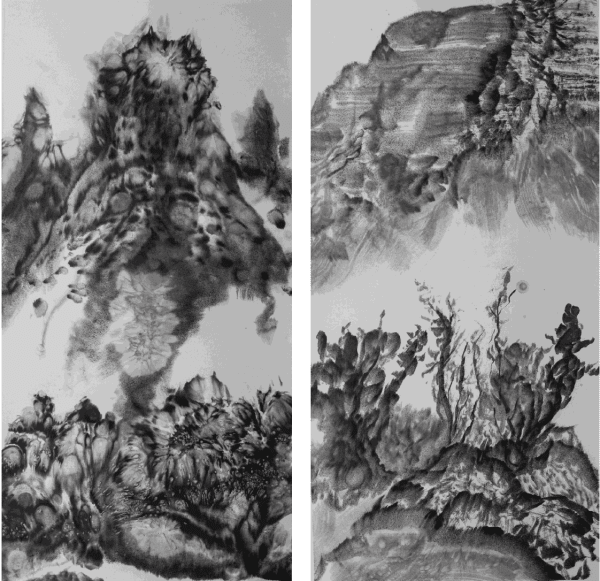March 14–26, 2022
Joan B Mirviss LTD
39 E 78th St Suite 401
New York, NY 10075
Inquires: yee.craig@inkstudio.com.cn (EN)
chu.nancy@inkstudio.com.cn (CN)
Performance
March 23, 2022, 6:30 pm US Eastern Time
China Institute
100 Washington Street
New York, NY 10006
For more information: https://www.chinainstitute.org/event/bingyis-lotus-dynasty/
The Taihang Mountains paintings evoke the lofty mountains and valleys of Song landscapes, but what lingers in the viewer’s mind is not their compositions, but rather the vivid rhythms of the myriad things communicated through the vibrations and nuances of brush and ink.
—Bingyi, Treatise on Landscape, 2022
Los Angeles-based artist, writer, film-maker, curator, cultural critic, and social activist Bingyi (b. 1975, Beijing) will premier Land of Immortals a new body of contemporary ink painting in a joint exhibition between INKstudio (Beijing) and Joan B. Mirviss (New York) during Asia Week New York 2022. Bingyi’s contemporary ink paintings will be shown alongside the contemporary ceramics of master artist Kondō Takahiro (b. 1958, Kyoto) in his concurrent solo exhibition Kondō Takahiro: Making Waves.
Land of Immortals will feature Bingyi’s most recent landscape paintings, created during and following her 2020-2021 research trip to the Taihang Mountains in Northern China’s Eastern Yellow-River Loess. The Taihang Mountains were home to three ink painters of the Song Dynasty (960 – 1279) who defined China’s monumental landscape painting tradition: Fan Kuan (c. 960 – c. 1030), Guo Xi (c. 1020 – c. 1090), and Li Tang (c. 1050 – 1130). From this history, Bingyi reconstructs an alternative landscape tradition that speaks not just to classical art connoisseurs in China and East Asia but to the global audiences of contemporary art today.
Born in Beijing and educated in the United States, Bingyi received her Ph.D. in art history from Yale University in 2005. Like the great literati artists of the past, Bingyi approaches painting as a personal practice of spiritual self-cultivation, as a speculative inquiry in the history of art and culture, and most importantly as an exploration into the nature of creativity.
During the Song Dynasty, under the influence of a philosophical renewal that integrated the humanism of Confucianism with a natural cosmology from Daoism, landscape became a near universal metaphor for this new vision of nature and humanity. Beginning in the 11th Century, however, the meaning of Chinese landscape shifted away from the natural back to the humanistic as naturalistic imagery was supplanted by expressive mark making or “brushwork”. Within this new “literati” mode of self-expression, control of the brush enabled the artist to manage and harness nature for human expressive purposes.
Bingyi’s new landscape painting language inverts this relationship. In her pursuit of a contemporary art language based on the traditional materials of brush, ink and paper, Bingyi uses ink as "dark light" to illuminate the partly invisible qualities and always transient behavior of water—nature’s universal solvent. By adding ink to water, Bingyi makes water and its behavior—such as flow, turbulence, diffusion and evaporation—visible to the human eye. Privileging the capacity of ink to make visible the qualities and processes of water and by extension nature, Bingyi creates an alternative history in which the brush mark expresses not the ego or the experience of the artist but rather serves the capacity of ink to express the qualities and processes of nature. In this move, she aligns herself with a long, alternate history of heterodox artistic movements—the splashed ink painters of the Tang Dynasty (618 – 907), the Chan monk artists Muqi (c. 13th Century) and Liang Kai (c. 1140 – c. 1210) of the Southern Song Dynasty (1127 – 1279), the mad Ming Dynasty (1368 – 1644) poet and playwright Xu Wei (1521 – 1593), and the 17th Century monk artists Shitao (1642 – 1707) and Zhu Da (c. 1626 – 1705).
About the Artworks
“In the Book of Changes, there is the Grand Terminus, which generates the Primeval Pair. The Primeval Pair produces the Four Forms, from which are derived the Eight Trigrams. The Eight Trigrams determine all good and evil, and therefrom arises the great complexity of life.” —The Book of Changes, App. I, Pt. I, 11
Unlike the conventional history of the “literati” landscape, which is primarily Confucian in nature, Bingyi’s speculative, heterodox history employs themes both Buddhist and Daoist to articulate a world of creative change and transformation that encompasses both nature and the nature of mind.
In the album, Eight Views of Bewilderment, Bingyi imagines an alternative to the Eight Views of the Xiao and Xiang Rivers a classical poetic and pictorial theme set in the Northern Song. In Bingyi’s conception, the eight views represent eight kinds of phenomenological experience accessible to the human mind. In naming her album wangxiang 罔象八景, she cites a story from the Zhuangzi (c. 4th Century B.C.) in which the unlikely character Xiang Wang 象罔 “Appears to be Ignorant” finds the way lost by the King when others who appear more qualified fail.
In the four hanging scrolls, Land of Immortals, Bingyi steps back into Han Dynasty (206 BC – AD 220) cosmology to explore the correspondence between the celestial and the earthly, the cosmic and the bodily. Each scroll—Green Dragon (East), White Tiger (West), Vermillion Phoenix (South), Black Tortoise and Snake (North)—represents one of the Si Xiang 四象or Four Mythical Gods and its associated cardinal direction and stellar constellations. Adding a center to the four cardinal directions, however, transforms the four directions into the five phases—Wood, Metal, Fire, Water and Earth. In this way, space (the four directions) and process unfolding in time (the five phases) find correspondence and unity.
In the two hanging scrolls White Clouds and Dark Beasts and Sound of the Empty Valley, Bingyi explores the mutually constitutive relationship between form and emptiness, active and passive, change and continuity—what in early Chinese thought is called yang and yin—alternating in never ending cycles of change and transformation. White Clouds and Dark Beasts cites a poem by Du Fu (712 – 770)—“a white cloud at one moment may look like a grey dog in the next”—conveying the idea that circumstances change from moment to moment in strange and unexpected ways. Sound of the Empty Valley, on the other hand, references Fan Kuan’s iconic landscape Travelers Among Mountains and Streams and how the still and empty space surrounding a monumental central peak is nevertheless resonant with movement and sound.
In the monumental single horizontal scroll, Paramita—literally “the Other Shore”—Bingyi depicts the land of illusion and human suffering and the other shore of perfect enlightenment linked by a bridge. The image of crossing over to the other shore is the realization of perfect enlightenment. In Chan Buddhism, however, the “other shore” of perfect enlightment is inseparable, identical, one-and-the-same with the shore of human suffering. The place that you left and the place where you arrive are one place.
About Joan B. Mirviss LTD
With more than forty-five years of experience, Joan B. Mirviss remains a pillar in the field of Japanese art. As a dealer, scholar, curator, and advisor, she has been the driving force championing the top Japanese clay artists, who she represents exclusively, and whose works she has placed in major museums around the globe. Widely published as a highly-respected expert, Mirviss has built many institutional and private collections of Japanese art. JOAN B MIRVISS LTD exhibits modern and contemporary Japanese ceramics, ukiyo-e, and Japanese paintings from its exclusive Madison Avenue location in New York City. For more information, please contact us at 212-799-4021 or director@mirviss.com.








